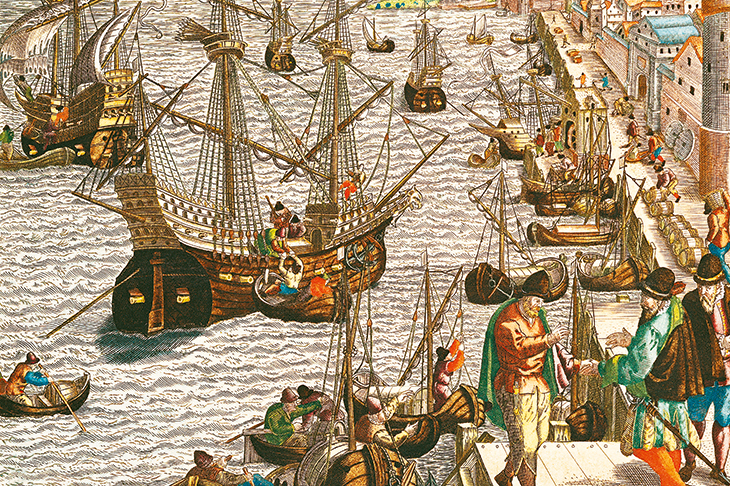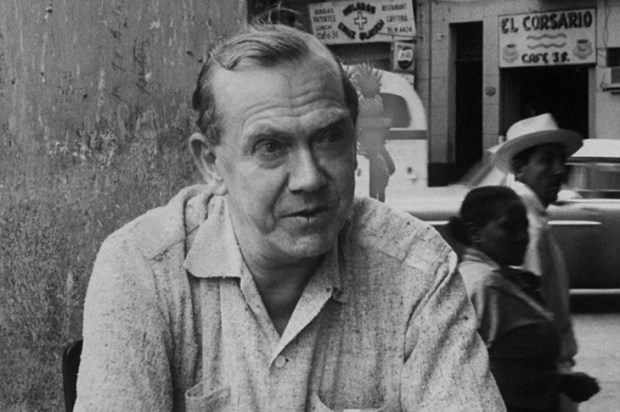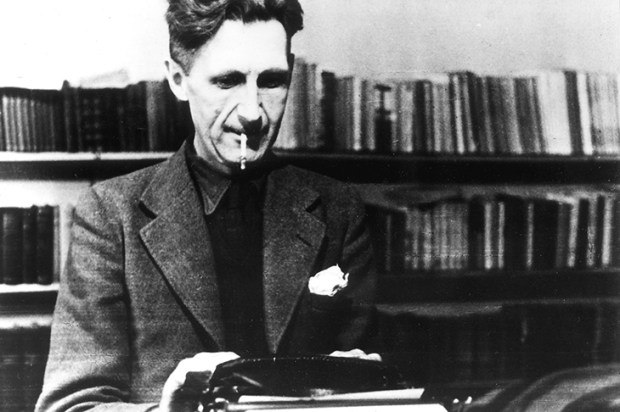Paris, Venice, Montevideo, Cape Town, Hobart. There are cities, like fado, that pluck at the gut. In my personal half dozen, having also lived there, Lisbon ranks high. ‘What beauties doth Lisboa first unfold,’ gasped Byron’s Childe Harold. Two centuries on, Portugal’s capital remains Queen of the Sea.
Yet beyond a sombrely sentimental gift to entrance, the character of Lisbon is elusive. It outreached the grip even of its greatest modern muse, Fernando Pessoa, whose posthumous 100-page guidebook, Lisbon: What the Tourist Should See, finally published in 1992, included the helpful information that Lisbon ‘rises like a fair vision in a dream, clear-cut against a bright blue sky which the sun gladdens with its gold’. Nor did Antoine de Saint-Exupéry penetrate to the nub on his visit in 1940 — when the city was a capital of refugees from the Nazis — describing Lisbon as ‘a kind of clear and sad paradise’ that ‘partied in defiance of Europe’.
To Barry Hatton in this enchanting history, ‘Lisbon is a mood’ which ‘cannot be captured in a travel brochure or photographs on a website’. The city’s special quality consists largely, he believes, in its exhilarating light, which falls on blue-tiled walls and white stone pavements with an intensity that is un-European, and more reminiscent of Portugal’s former colonies in Africa, India and Brazil. ‘It is a textured brightness, a creamy glow, at the same time vivid and silky.’
Lisbon’s second unique ingredient is what one Portuguese historian has called the ‘hybridism of cultures where, like nowhere else, the influences of Christianity and Islam converged’. To the Nobel laureate José Saramago, the city’s spirit lies in this spicy stew, ‘and it is the spirit that makes cities eternal’. Lisbon’s cultural tolerance throws up: the footballer Eusébio (from Lourenço Marques) — his statue ‘poised in mid-kick’ outside the Benfica Stadium of Light; the Belém Tower — whose architect had worked for two years in Marrakesh and was mimicking its mosque there; and São Domingos Square — where you can purchase a voodoo spell from Ouidah, drink throat-pinching firewater from Cape Verde, and eat an eye-watering Mozambican curry while listening to kizomba music from Angola.
‘Its secret,’ Hatton reckons, ‘is in the mix.’
Hatton has little truck with the myths that Lisbon’s citizens — Europe’s ‘most instinctively subversive people’ — like to tell themselves. It’s a furphy that Ulysses founded Lisbon after becoming lost in the Mediterranean, and that it was the Phoenician city of Alis Ubbo (allegedly meaning Gentle Cove). Still, an excavation in 2014 did uncover a Phoenician cemetery dating back to the seventh century bc, while a recent dig unearthed virtually the largest hippodrome in the Roman Empire, when the city was known as Olisipo.
Roman for six centuries, Moorish for five more (as Al-Uxbuna), Lisbon did not come of age (as Lixboa) till long after the Crusaders reconquered it (in 1147). Then, trapped between the devil of Spain and the deep blue Atlantic, it chose ‘faute de mieux, to get wet’.
The Age of Discovery — which began with the conquest of Ceuta in 1415 by Henry the (half-English) Navigator, and continued in a staccato flourish with Bartolomeu Dias’s rounding of the Cape in 1488, Vasco da Gama’s arrival in India in 1498, and Pedro Cabral’s landing on the Brazilian coast in 1500 — catapulted Lisbon into opulence and prominence as ‘the place to be if you wanted news on what was happening across the globe’. In the phrase of its national poet, Luís de Camões, Portugal brought ‘new worlds to the world’. By 1608, Lisbon was ‘worthy of being the head of the empire of the whole world’, according to one leading nobleman who argued to Felipe III of Spain that the city should even replace Madrid as the capital of Iberia.
Lisbon flaunted its wealth in wildly extravagant construction projects like the Jerónimos Monastery — said to be ‘built by pepper’, and taking a century to complete — and in the monarch’s exotic cortege whenever he proceeded through the streets, composed of a rhinoceros, five elephants, ‘rigged out in gold brocade’, and a jaguar.
No less characteristic was the opposite asceticism that motivated some of Manuel I’s successors. Typical of these was the former economics professor António Salazar, an unmarried cold fish who ruled from 1932 to 1968, living with his housekeeper Maria in a rented home, a rug over his knees, and keeping chickens and rabbits in the yard, while banning Coca-Cola and the exposure of bare flesh on the beach.
Hatton is skilful at assembling these contradictions. There is the Lisbon light, he suggests, and then there is the city’s darkness. The sweet-scented Queen of the Sea was in the same warm breath a filthy, disease-ridden sewer — ‘a chaos of nastiness, poverty and wretchedness on every side’, observed an English officer who arrived in the Peninsula War. The ingrained habit of hurling into the street below the contents of your chamber pot with the cry Água vai! (Here comes water!) had not shifted an iota by 1940 when the American writer Mary McCarthy visited. She was struck by the Dickensian hardship that she witnessed in the still ‘medieval’ poverty of the Alfama district.
Add to cholera and diphtheria a condition that continues to infect Lisbon’s historians. Hatton diagnoses this as a ‘cultural amnesia’. Unpalatable blots are instinctively scrubbed from the capital’s history and put ‘in a box in the attic’. Rather as the Marquis de Pombal prohibited the use of the surname Távora, after the Marquis of Távora tried to assassinate him, so, for example, has Salazar’s name been removed from the magnificent bridge across the River Tagus that in 1966 was baptised after him. Even today, references to Salazar’s 36-year dictatorship are suppressed.
Locked away as well in that same attic box is the shameful story of how Jews and blacks were treated. The 400,000 African slaves who arrived in Lisbon between 1444 and 1761 — the only ones who didn’t have slaves in the 16th century ‘were the beggars’ — are a ‘silent presence’ in the history books, along with the estimated 5.8 million Africans shipped to Brazil between 1501 and 1857.
A beautiful face always carries a price. Hatton never forgets that Lisbon’s seductively peaceful, shabby charm conceals features that are also sinister and brutal. The 1974 revolution that saw the end of Salazar’s legacy resulted in only five deaths, with the ecstatic population stuffing carnations into the gun-barrels of soldiers, and the deposed prime minister Marcelo Caetano murmuring, ‘Well, that’s life,’ as he got into the car that drove him away. But a commensurate violence shimmers never far from the surface, and on All Saints Day 1755 it famously erupted with what Goethe called ‘diabolic terror’.
In seven minutes one of the most powerful earthquakes to hit Europe obliterated a tenth of Lisbon’s 200,000 population, two thirds of its houses, 36 churches, the world’s most sumptuous opera house, and a royal palace containing priceless archives from Portugal’s golden Age of Discovery. All that was left after the tsunami, the fires and 250 aftershocks was ‘a vast heap of ruins’. Lisbon never altogether recovered.
My favourite books on cities include Suketu Mehta’s portrait of Mumbai, Maximum City, and Jan Morris’s Trieste and the Meaning of Nowhere. This is more idiosyncratic and playful. A foreign correspondent in Portugal’s capital for 30 years, Hatton has eschewed ‘a linear, historical narrative’ in order to tell Lisbon’s story ‘from the inside’. In joining up his dots, he makes no space for writers like Antonio Tabucchi or António Lobo Antunes, or for scandals like the architect Tomás Taveira’s sex-tapes, which convulsed the city in the 1980s.
In their place he gives us the scandal of Queen Amália I of Kongo, who after her coronation in Lisbon ran off with a farmer from the Alentejo, bearing him many children. The story I like best is that of the contemporary-sounding swindler whose gargantuan fraud may have opened the door to Salazar’s rule. In 1925, a bankrupt undertaker’s son, Artur Alves dos Reis, succeeded in conning the London printers Waterlow & Sons, which printed Portuguese bank notes, into issuing him with 200,000 genuine notes of 500 escudos, equivalent to 1 per cent of Portugal’s annual GDP. He lived the highest of lives before he was caught and imprisoned, dying, like Camões, in poverty and obscurity. A very Lisbon story.
Got something to add? Join the discussion and comment below.
Get 10 issues for just $10
Subscribe to The Spectator Australia today for the next 10 magazine issues, plus full online access, for just $10.
You might disagree with half of it, but you’ll enjoy reading all of it. Try your first month for free, then just $2 a week for the remainder of your first year.














Comments
Don't miss out
Join the conversation with other Spectator Australia readers. Subscribe to leave a comment.
SUBSCRIBEAlready a subscriber? Log in